Aiserman M., Gusev L., Rozonoer L., Smirnova l., Tal A. Logic, Automata, and Algorithms
Подождите немного. Документ загружается.

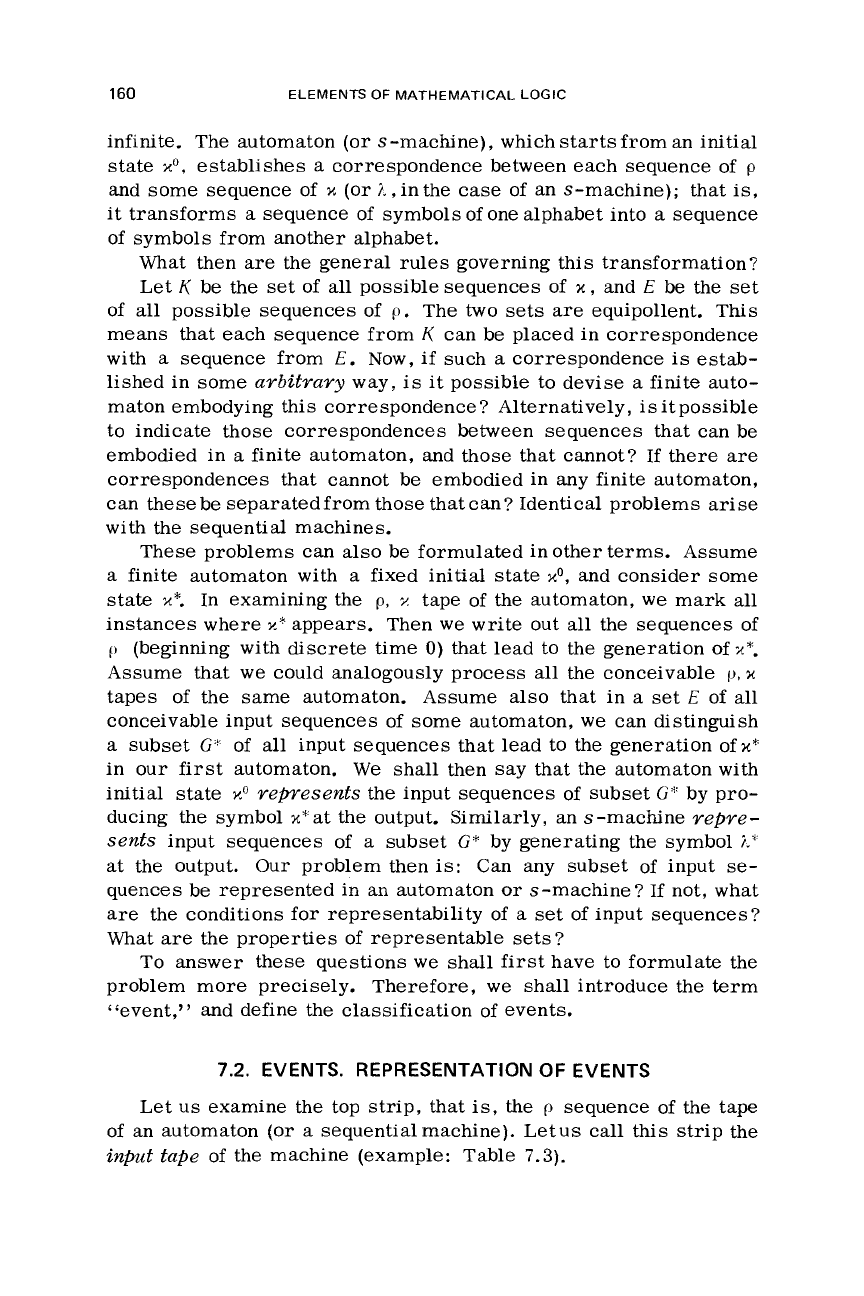
160
ELEMENTS
OF
MATHEMATICAL
LOGIC
infinite. The automaton
(or
s-machine), which
starts
from an
initial
state
x@,
establishes
a
correspondence between
each
sequence
of
p
and some sequence of
y.
(or
i.,
in
the
case
of an s-machine); that
is,
it transforms
a
sequence of symbols of one alphabet into
a
sequence
of symbols from another alphabet.
What then are the general rules governing this transformation?
Let
K
be the set of
all
possible sequences of
H,
and
E
be
the set
of
all
possible sequences
of
p.
The
two
sets
are
equipollent.
This
means that each sequence from
K
can be placed in correspondence
with
a
sequence from
E.
Now,
if
such
a
correspondence
is
estab-
lished in some
arbitrary
way,
is
it
possible to devise
a
finite auto-
maton embodying this correspondence
?
Alternatively,
is
it possible
to indicate those correspondences between sequences that can be
embodied in
a
finite automaton, and those that cannot? If there
are
correspondences that cannot be embodied in any finite automaton,
can these be separatedfrom those
that
can?
Identical problems
arise
with the sequential machines.
These problems can also be formulated in other terms. Assume
a
finite automaton with
a
fixed initial state
xo,
and consider some
state
x".
In examining the
p,
z
tape of the automaton,
we
mark
all
instances
where
x*
appears. Then
we
write out
all
the
sequences
of
11
(beginning with discrete time
0)
that
lead to the generation
of
x".
Assume that
we
could analogously process
all
the conceivable
p,
x.
tapes of the same automaton. Assume also that in
a
set
E
of
all
conceivable input sequences of some automaton, we can distinguish
a
subset
G:'
of
all
input sequences that
lead
to the generation of%*
in our first automaton.
We
shall then say that the automaton with
initial state
x@
represents
the input sequences of subset
G?:
by pro-
ducing the symbol x"at the output. Similarly, an s-machine
Yepre-
sents
input sequences of
a
subset
G"
by generating the symbol
La
at the output.
Our
problem then
is:
Can any subset
of
input
se-
quences be represented in an automaton
or
s-machine?
If
not, what
are
the conditions for representability of
a
set of input sequences?
What
are
the properties of representable sets?
To answer these questions
we
shall
first have to formulate the
problem more precisely. Therefore,
we
shall introduce the term
"event." and define the classification of events.
7.2.
EVENTS. REPRESENTATION
OF
EVENTS
Let us examine the top strip, that
is,
the
p
sequence of
the
tape
of an automaton
(or
a
sequential machine). Let us
call
this strip the
input
tape
of the machine (example: Table
7.3).
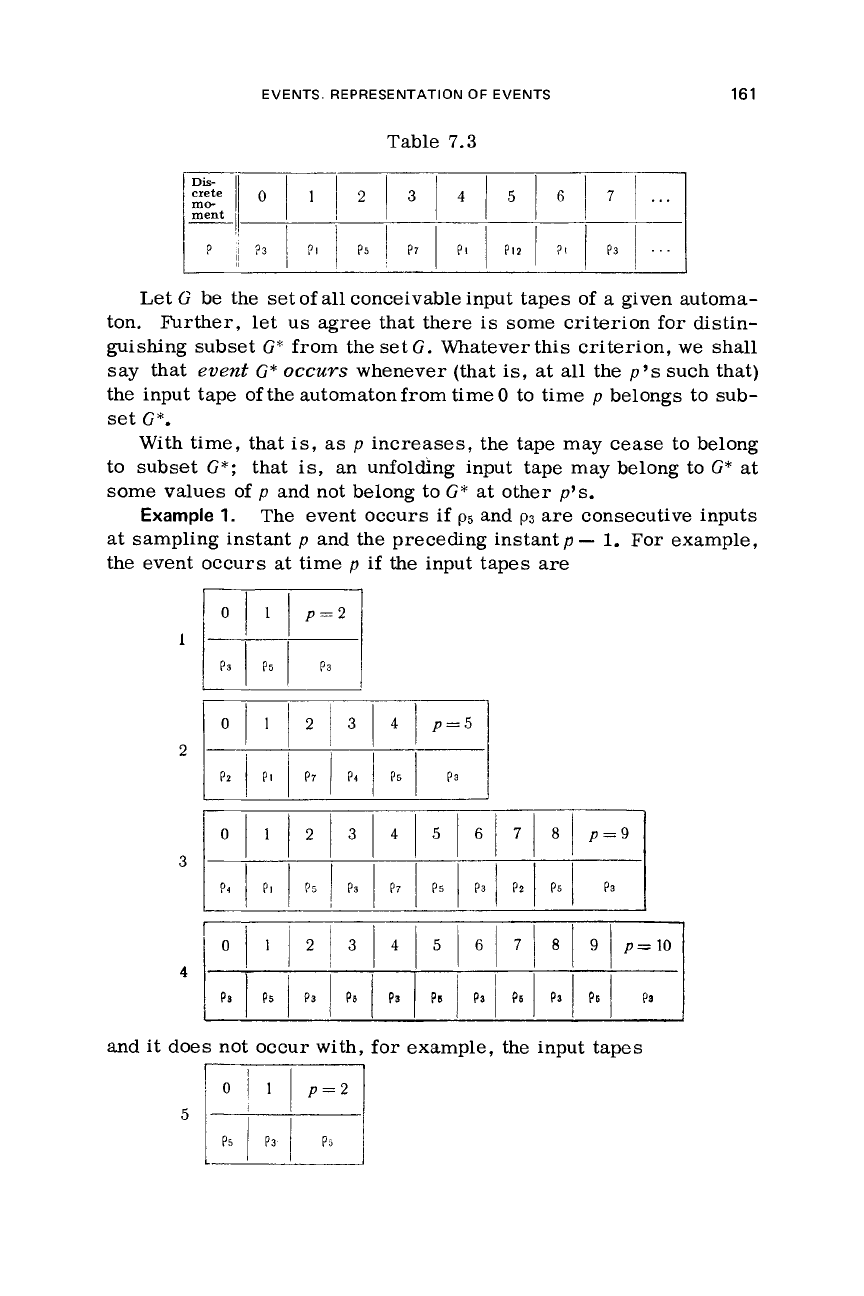
EVENTS. REPRESENTATION
OF
EVENTS
161
Table
7.3
Let
G
be the
set
of
all
conceivable input tapes of
a
given automa-
ton.
Further, let us
agree
that there
is
some criterion
for
distin-
guishing subset
G*
from the set
G.
Whatever
this
criterion,
we
shall
say
that event
G*
OCCUYS
whenever (that is, at
all
the
p’s
such that)
the input tape of the automaton from time
0
to time
p
belongs to sub-
set
G*.
With time, that
is,
as
p
increases, the tape may
cease
to belong
to subset
G*;
that is, an unfolding input tape may belong to
G*
at
some values of
p
and not belong
to
G*
at other
p’s.
Example
1.
The event occurs
if
p5
and
p3
are
consecutive inputs
at
sampling instant
p
and the preceding instant
p
-
1.
For
example,
the event occurs at time
p
if
the input tapes
are
and
it
does not occur with, for example, the input
tapes
5
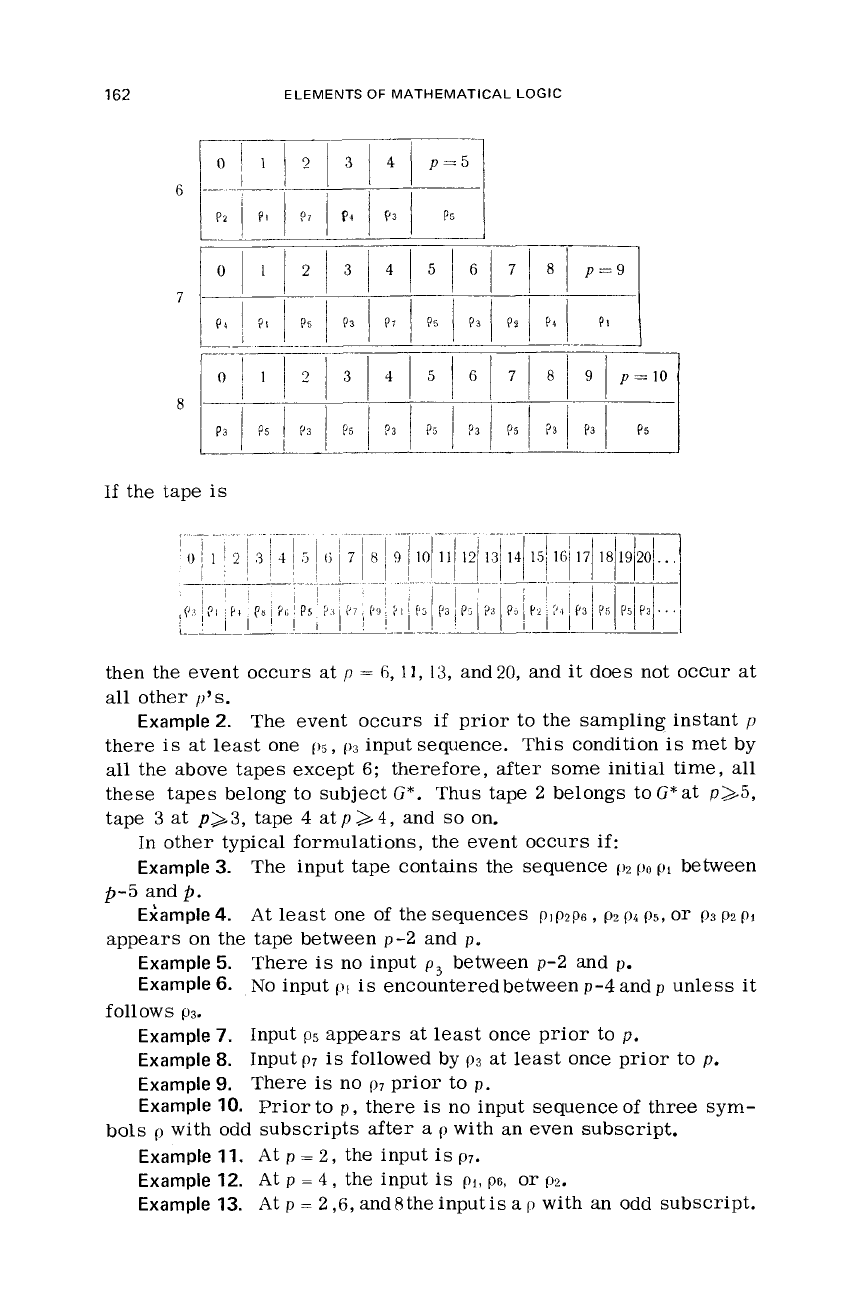
162
ELEMENTS
OF
MATHEMATICAL LOGIC
If
the tape
is
then the event occurs at
p
=
6,
1
I,
13,
and
20,
and it does not occur at
all other
p's.
Example
2.
The event occurs
if
prior to the sampling instant
[I
there
is
at least one
05,
p3
input sequence. This condition
is
met by
all
the above tapes except
6;
therefore, after some initial time,
all
these tapes belong to subject
G*.
Thus tape
2
belongs toG*at
PAS,
tape
3
at
p>3,
tape
4
at
p
>/
4,
and
so
on.
In other typical formulations,
the
event occurs
if:
Example
3.
The input tape contains the sequence
pz
c)o
pI
between
Eiample
4.
At least one of the sequences
pIp2p6,
QZ
p4
p5,
or
p3
pz
PI
Example
5.
There
is
no input
p3
between
p-2
and
p.
Example
6.
No
input
131
is
encounteredbetween
p-4
and
p
unless it
Example
7.
Input
p5
appears at
least
once prior to
p.
Example
8.
Input
p7
is
followed by
p3
at least once prior to
p.
Example
9.
There
is
no
p7
prior to
p.
Example
10.
Prior to
p,
there
is
no input sequence
of
three sym-
Example
11.
At
p
=
2,
the input
is
p7.
Example
12.
At
p
=
4,
the
input
is
pi,
p6,
or
(12.
Example
13.
At
p
=
2,6,
and8the inputis
a
with an odd subscript.
p-5 andp.
appears on the tape between
p-2
and
p.
follows
03.
bols
p
with odd subscripts
after
a
Q
with an even subscript.
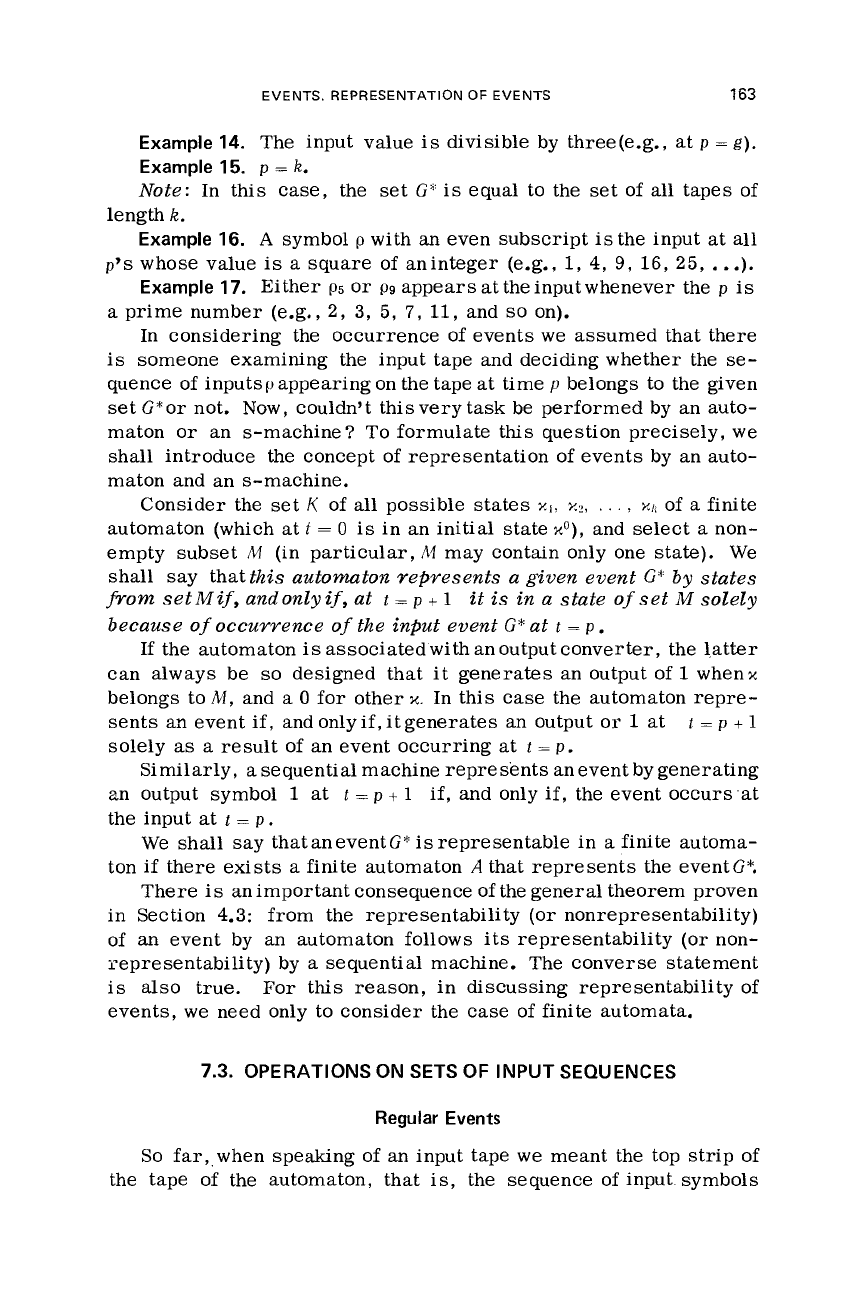
EVENTS. REPRESENTATION
OF
EVENTS
163
Example 14.
The input value
is
divisible by three(e.g., at
p
=
g).
Example 15.
p
=
k.
Note:
In this case, the set
Ga
is
equal to the set of
all
tapes of
length
k.
Example 16.
A
symbol
p
with an even subscript
is
the input
at
all
p’s
whose value
is
a
square of aninteger (e.g.,
1,
4,
9,
16,
25,
.
.
.).
Example 17.
Either
p5
or
PS
appears
at
the input whenever the
p
is
a
prime number (e.g.,
2,
3,
5,
7,
11,
and
so
on).
In considering the occurrence of events
we
assumed that there
is
someone examining the input tape and deciding whether the
se-
quence of inputs
y
appearing on the tape at time
p
belongs to the given
set
G*or
not. Now, couldn’t thisverytask be performed by
an
auto-
maton
or
an s-machine? To formulate
this
question precisely,
we
shall introduce the concept of representation of events by an auto-
maton and an s-machine.
.
,
XI,
of
a
finite
automaton (which at
t
=
0
is
in an initial state
xo),
and select
a
non-
empty subset
M
(in particular,
M
may contain only one state).
We
shall say that
this automaton represents a given event
G’
by
states
from
setMif, andonlyif,
at
t
=
p
t
1
it
is in a state of set
M
solely
because of occuvrence
of
the input event
G*
at
t
=
p.
If the automaton
is
associated with an output converter, the latter
can always be
so
designed that it generates an output of
1
whenlt
belongs to
M,
and
a
0
for other
x..
In this case the automaton repre-
sents an event
if,
and only
if,
it generates an output or
1
at
t
=
p
+
1
solely
as
a
result of an event occurring
at
t
=
p.
Similarly,
a
sequential machine represents anevent by generating
211
output symbol
1
at
t
=
p
+
1
if,
and only if, the event occurs
at
the input at
t
=
p.
We
shall say that aneventG’
is
representable in
a
finite automa-
ton
if
there exists
a
finite automaton
A
that represents the eventG*.
There
is
an important consequence of the general theorem proven
in Section
4.3:
from the representability
(or
nonrepresentability)
of an event by an automaton follows its representability
(or
non-
representability) by
a
sequential machine. The converse statement
is
also
true.
For
this reason, in discussing representability of
events,
we
need only to consider the
case
of finite automata.
Consider the set
K
of
all
possible states
xi, x?,
7.3. OPERATIONS
ON
SETS OF INPUT SEQUENCES
Regular Events
So
far,,when speaking of
an
input tape
we
meant the top strip of
the tape
of
the automaton, that
is,
the sequence
of
input. symbols
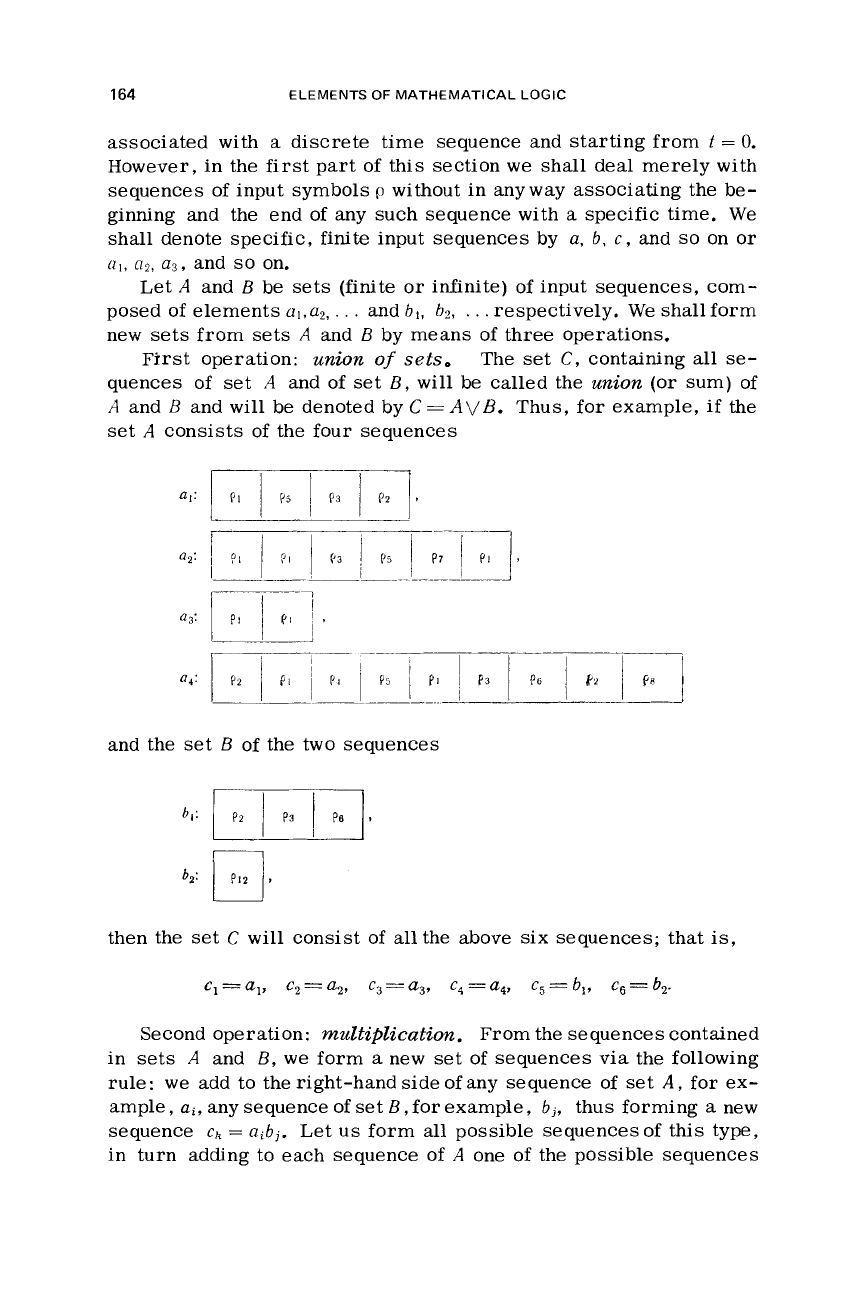
164
ELEMENTS
OF
MATHEMATICAL LOGIC
associated with
a
discrete time sequence and starting from
f
=
0.
However, in the first part of this section
we
shall
deal
merely with
sequences of input symbols
p
without in anyway associating the be-
ginning and the end of any such sequence with
a
specific time.
We
shall
denote specific,
finite
input sequences by
a,
6,
c,
and
so
on
or
nl,
clp,
a3,
and
so
on.
Let
A
and
B
be sets (finite
or
infinite) of input sequences, com-
posed
of
elements
al,a2,
.
. .
and
b,,
h,
.
.
.
respectively.
We
shall
form
new
sets
from
sets
A
and
B
by means of
three
operations.
The set
C,
containing
all
se-
quences
of
set
A
and of set
B,
will be called the
union
(or
sum) of
A
and
B
and will be denoted by
C=
AVB.
Thus, for example,
if
the
set
A
consists of the four sequences
First operation:
union
of
sets.
and the set
B
of the two sequences
then the set
C
will
consist of
all
the above six sequences; that
is,
c1
=a,,
c2
=
u2,
c3
=
u3,
C~
=
u4,
c5
=
61,
c6
=
6,.
Second operation:
multiplication.
From the sequences contained
in sets
A
and
B,
we
form
a
new set of sequences via the following
rule:
we
add
to the right-hand side of any sequence of set
A,
for ex-
ample,
ai,
any sequence of set
B
,
for example,
bj,
thus forming
a
new
sequence
ch
=
nibj.
Let
us
form
all
possible sequences of
this
type,
in turn adding to
each
sequence of
A
one of the possible sequences
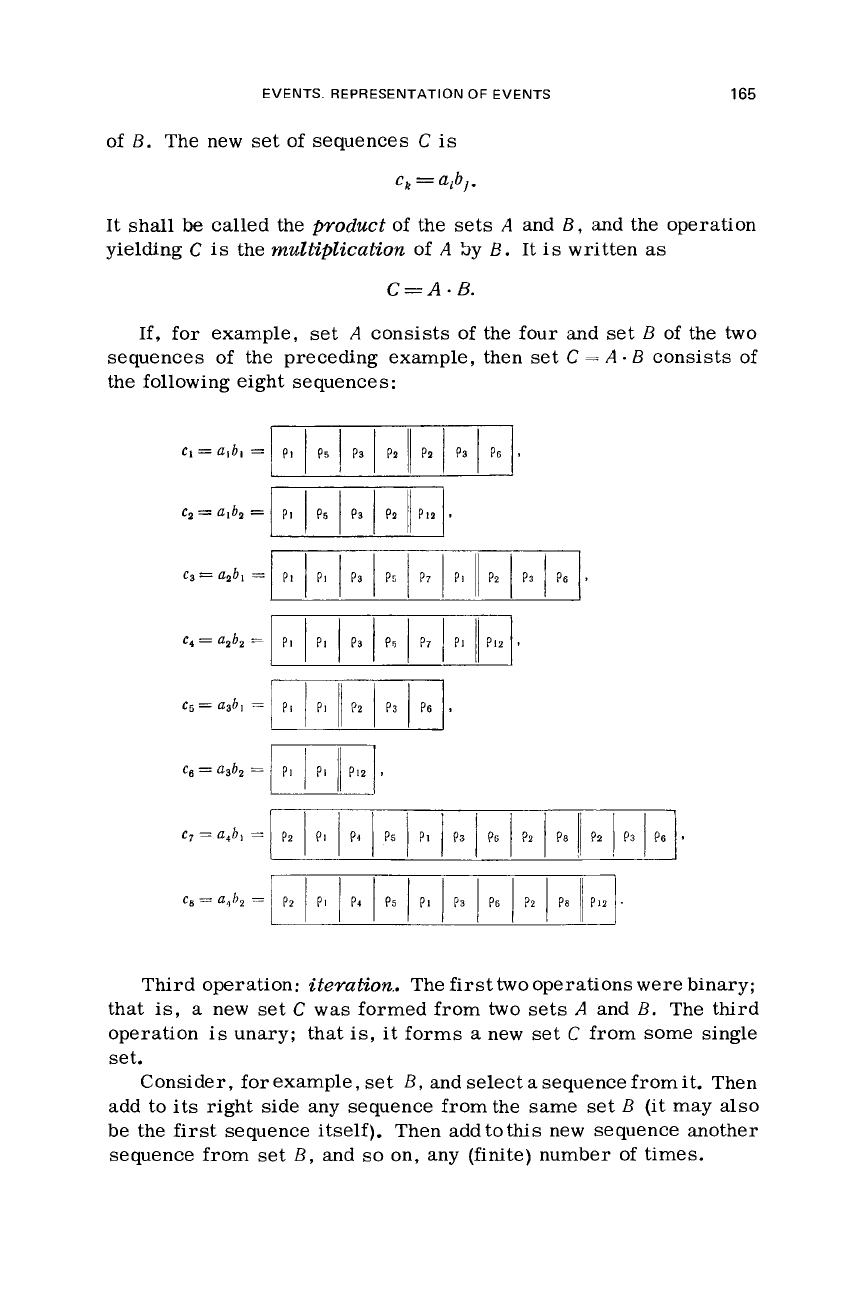
EVENTS. REPRESENTATION
OF
EVENTS
165
of
B.
The new set of sequences
C
is
CR
=
alb,.
It shall
be
called
the
product of the sets
A
and
B,
and the operation
yielding
C
is
the multiplication of
A
by
L?.
It
is
written
as
C=A*B.
If, for example,
set
A
consists of
the
four and set
B
of the two
A-B
consists of sequences of the preceding example, then set
C
the following eight sequences:
Third operation: iteration.. The
first
two
operations
were
binary;
that
is,
a
new set
C
was
formed from
two
sets
A
and
B.
The third
operation
is
unary; that
is,
it forms
a
new set
C
from some single
set.
Consider, for example, set
B,
and
select
a
sequence from it. Then
add to
its
right side any sequence from the same set
B
(it may also
be the first sequence itself). Then addtothis new sequence another
sequence from set
B,
and
so
on, any (finite) number of times.
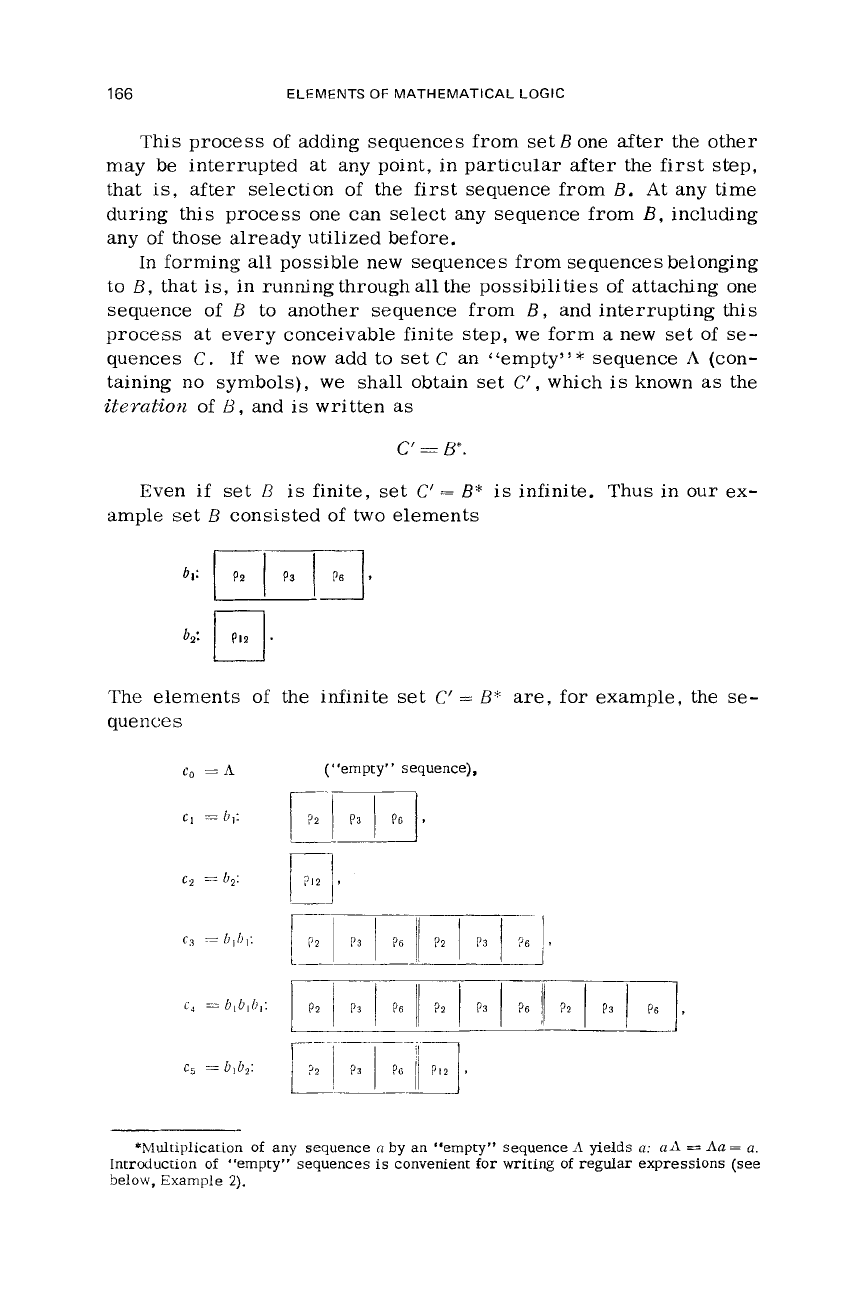
166
ELEMENTS
OF
MATHEMATICAL LOGIC
This process of adding sequences from set
B
one after the other
may
be
interrupted at any point, in particular after the first step,
that
is,
after selection of the first sequence from
B.
At any time
during this process one can select
any
sequence from
B,
including
any of those already utilized before.
In
forming all possible new sequences from sequences belonging
to
H,
that
is,
in running through
all
the possibilities of attaching one
sequence of
B
to another sequence from
B,
and interrupting this
process at every conceivable finite step, we form
a
new set
of
se-
quences
C.
If
we
now
add
to
set
C
an ‘‘emptyY’* sequence
A
(con-
taining no symbols), we shall obtain set
C’,
which
is
known
as
the
itemtiox
of
B,
and
is
written
as
Even
if
set
U
is
finite, set
C’
=
B*
is
infinite. Thus in our ex-
ample set
B
consisted
of
two elements
The elements
of
the infinite set
C‘
=
Be
are, for example, the
se-
quences
to
=
A
(
‘
‘empty‘
’
sequence),
*Multiplication
of
any sequence
n
by an “empty” sequence
A
yields
a:
uil
=
Aa
=
a.
Introducuon
of
“empty” sequences
is
convenient
for
writing
of
regular expressions (see
below, Example
2).
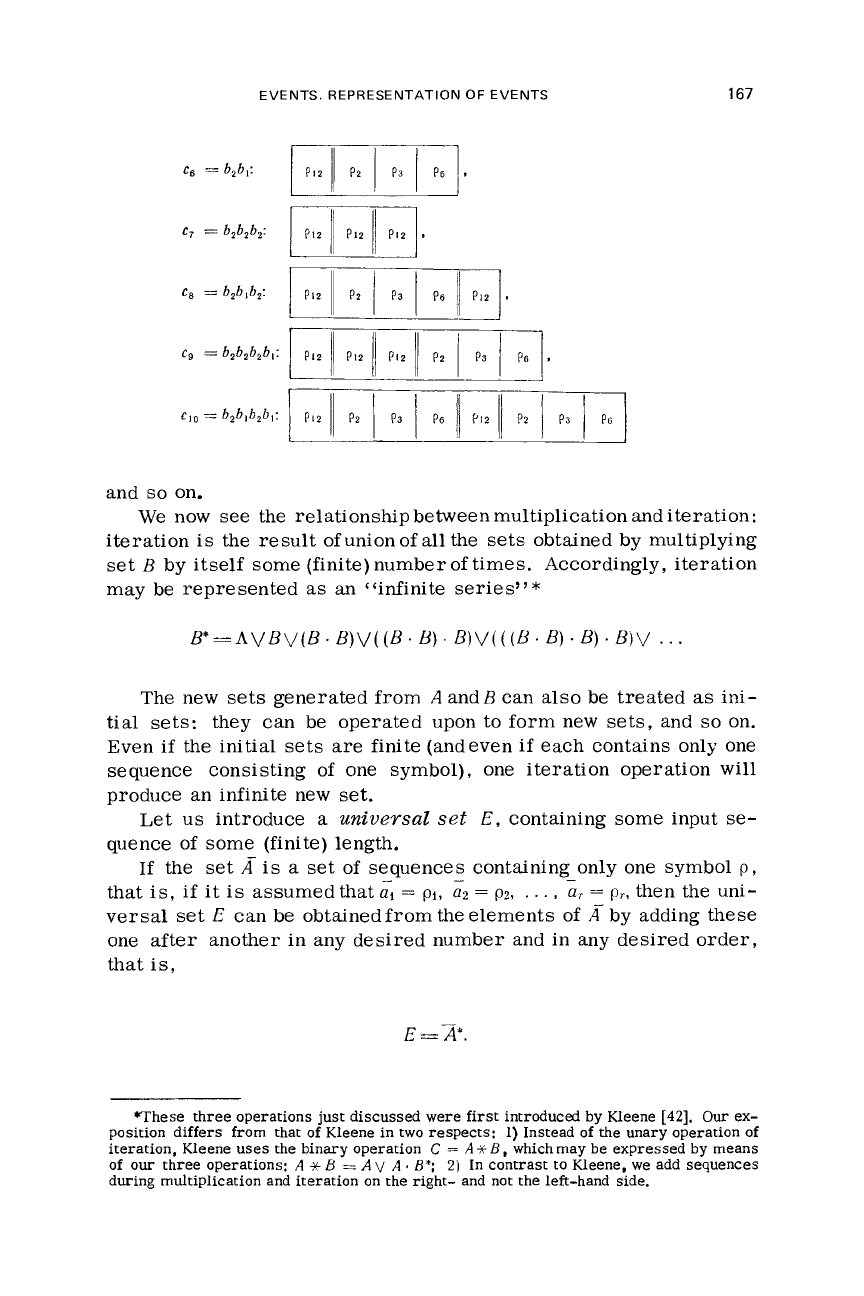
EVENTS. REPRESENTATION
OF
EVENTS
167
and
so
on.
We
now
see
the relationship between multiplication and iteration:
iteration
is
the result of union
of
all
the sets obtained by multiplying
set
B
by itself some (finite) number of times. Accordingly, iteration
may be represented as an “infinite series”*
B*=
AVBV(B.
B)V(
(B
.
B)
.
B)V(
(
(U
.
B)
.
B)
.
U)V
. .
.
The new
sets
generated from
A
and
B
can also be treated
as
ini-
tial
sets: they can be operated upon to form new sets, and
so
on.
Even
if
the
initial
sets
are
finite (andeven
if
each contains only one
sequence consisting of one symbol), one iteration operation will
produce an infinite new
set.
Let us introduce
a
universal
set
E,
containing some input
se-
quence of some (finite) length.
If
the set
is
a
set of sequences containing
-
only one symbol
p,
that
is,
if
it
is
assumed that
=
pi,
u2
=
pz,
.
.
.
,
a,
=
pr,
then the uni-
versal set
E
can be obtainedfrom theelements of by adding these
one after another in any desired number and in any
desired
order,
that
is
,
-
‘These three operations just discussed were first introduced by Kleene
[42].
Our
ex-
position differs from that
of
Kleene in two respects:
1)
Instead of the unary operation of
iteration, Kleene
uses
the binary operation
C
=
AxB,
whichmay be expressed by means
of
our three operations:
A
*
B
=
A
v
A
+
B*;
2)
In
contrast to Kleene, we add sequences
during multiplication and iteration
on
the right- and not the left-hand side.
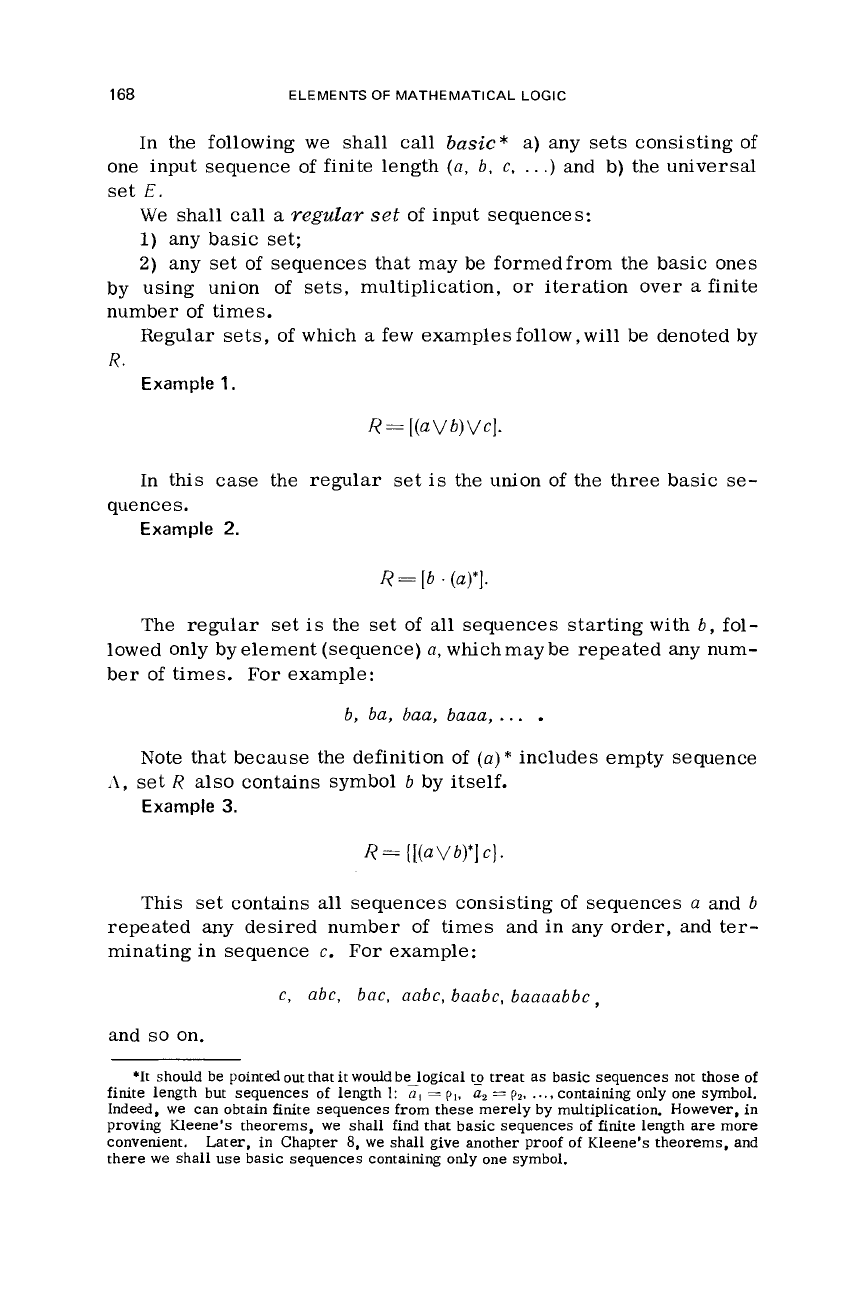
168
ELEMENTS
OF
MATHEMATICAL LOGIC
In the following we shall call
basic*
a)
any sets consisting of
one input sequence of finite length
(a, b. c,
. .
.)
and b) the universal
set
E.
We
shall
call
a
regular
set
of input sequences:
1)
any basic set;
2)
any set of sequences that may be formedfrom the basic ones
by using union of sets, multiplication, or iteration over
a
finite
number of times.
Regular sets, of
which
a
few
examplesfollow,
will
be denoted by
R.
Example
1.
In this case the regular set
is
the union of the three basic
se-
Example
2.
quences.
I?
=
[b
.
(a)*].
The regular set
is
the set of all sequences starting with
b,
fol-
lowed only by element (sequence)
a,
which may be repeated any num-
ber
of
times. For example:
b, ba, baa, baaa,
...
.
Note that because the definition of
(a)
*
includes empty sequence
Example
3.
,\,
set
R
also contains symbol
b
by itself.
This set contains
all
sequences consisting of sequences
a
and
b
repeated any desired number of times and in any order, and ter-
minating in sequence
c.
For example:
c,
abc, bac, aabc, baabc, baaaabbc,
and
so
on.
*It should be pointed out that
it
would belogical ts treat as basic sequences
not
those of
finite length but sequences of length
1:
a,
=
p,,
a2
=
p2,
...,
containing only one
symbol.
Indeed, we can obtain finite sequences from these merely by multiplication. However, in
proving Kleene’s theorems, we shall find that basic sequences of finite length are more
convenient. Later, in Chapter
8,
we shall give another proof of Kleene’s theorems, and
there we shall use basic sequences containing only one symbol.
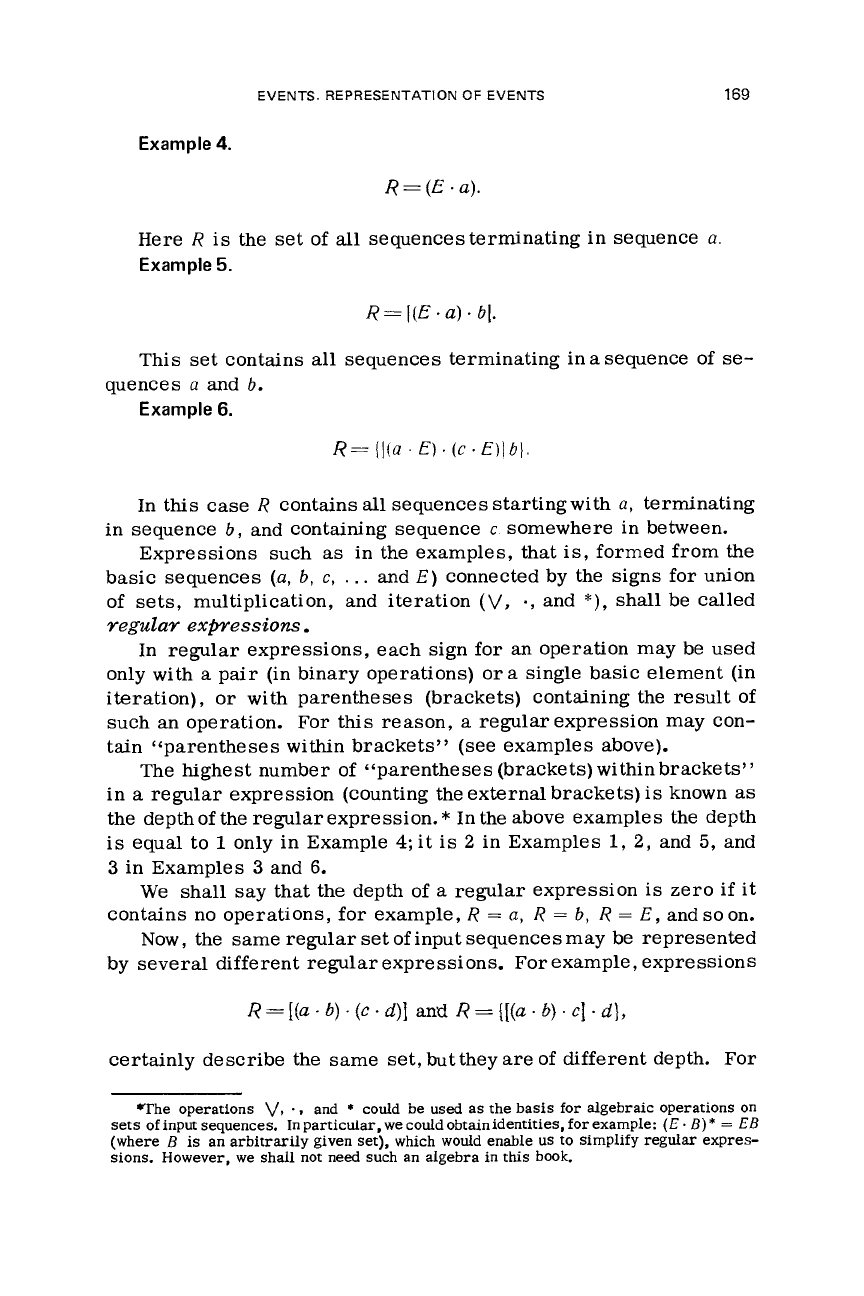
EVENTS. REPRESENTATION
OF
EVENTS
169
Example
4.
Here
R
is
the
set
of
all
sequences terminating in sequence
a.
Example
5.
This set contains
all
sequences terminating in
a
sequence of
se-
quences
a
and
b.
Example
6.
R=
(I!a
’
E).
(c.
E)lb).
In this
case
R
contains
all
sequences startingwith
a,
terminating
in sequence
6,
and containing sequence
c
somewhere in between.
Expressions such
as
in
the
examples, that
is,
formed from
the
basic sequences
(a,
b,
c,
.
.
.
and
E)
connected by the signs for union
of sets, multiplication, and iteration
(V,
-,
and
*),
shall be called
regular
expressions.
In regular expressions, each sign for
an
operation may be used
only with
a
pair (in binary operations)
or
a
single basic element (in
iteration),
or
with parentheses (brackets) containing the result of
such an operation. For
this
reason,
a
regular expression may con-
tain “parentheses within brackets”
(see
examples above).
The highest number of “parentheses (brackets) within brackets’’
in
a
regular expression (counting
the
external brackets)
is
known
as
the depth of
the
regular expression.
*
In the above examples the depth
is
equal to
1
only in Example
4;
it
is
2
in Examples
1,
2,
and
5,
and
3
in Examples
3
and
6.
We
shall say that the depth of
a
regular expression
is
zero
if
it
contains no operations, for example,
R
=
a,
R
=
b,
R
=
E,
and
so
on.
Now,
the
same regular
set
of input sequences may be represented
by several different regular expressions. For example, expressions
R
=
[(a
.
6)
(c
d)]
and
R
=
{[(a
6)
.
c]
-
d),
certainly describe the same set, but they
are
of different depth.
For
The operations
v,
*,
and
*
could be used
as
the basis
for
algebraic operations on
sets
of
input sequences.
In
particular,
we
could obtainidentities,
for
example:
(E
B)
*
=
EB
(where
B
is
an arbitrarily given set), which would enable us to simplify regular expres-
sions. However, we shall not need such an algebra in this book.
